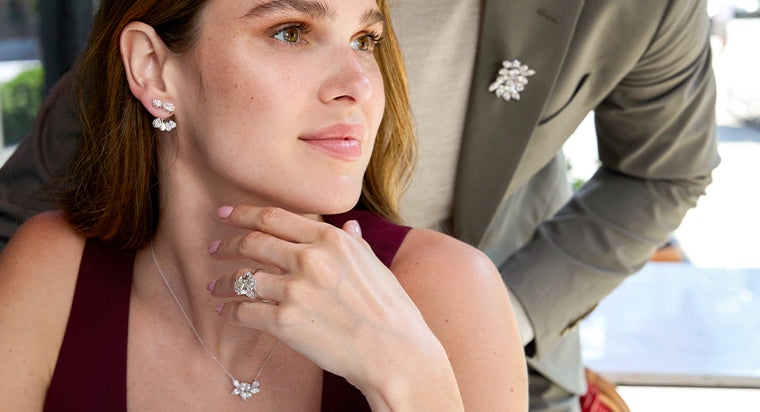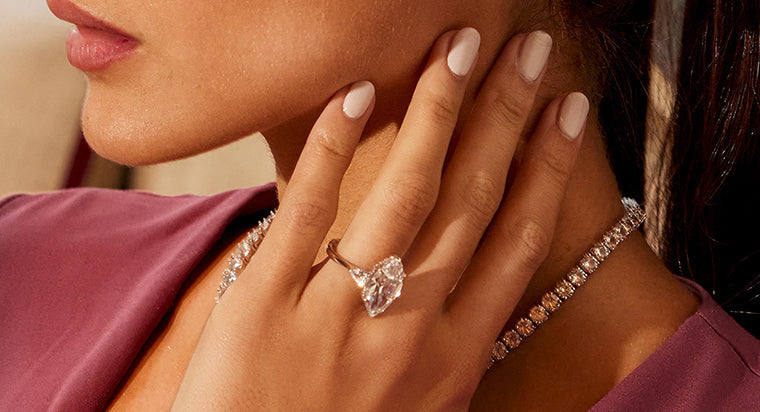Buying Guide for Diamond Jewelry

Diamond jewelry represents elegance, love, and celebration. It's no wonder that it's used to celebrate life's smallest and biggest milestones. Diamonds look timeless, so they'll always be in style and are built to last. If you're looking for a new piece of diamond jewelry for yourself or someone in your life, we'll cover the diamond basics so you can feel content about your gorgeous purchase (4Cs, settings, metals).
TABLE OF CONTENTS
Understand the 4Cs: Cut, Color, Clarity, and Carat
Lab grown diamond and natural diamonds are graded for cut, color, clarity, and carat weight—these are also called the 4Cs. These aspects determine diamond quality and impact its cost. Cut is generally the most important factor for diamonds because it impacts the stone's brilliance. It also impacts the overall look because it's the diamond shape (oval, round, princess, or emerald). Color is graded from D (colorless) to Z (noticeable tint)—near-colorless grades like G through J appear bright for the price. Clarity refers to natural imperfections. Many are invisible to the naked eye, so lower grades like VS2 or SI1 can still look flawless. Carat measures diamond size, but a well-cut diamond can appear larger than a heavier one. Choosing just below a full carat amount, such as 0.90 ct rather than 1.00 ct, can save money without compromising on the look.
Choose the Right Type of Diamond Jewelry
Now is the fun part—diamond jewelry comes in all different types from engagement rings to diamond tennis bracelets and everything in between. Browse different categories at With Clarity so you can see the amount of available pieces. Engagement rings are deeply symbolic pieces that represent commitment and love. They can be personalized based on style, daily routine, and preferred metal or diamond shape. With Clarity makes it easy to do this, too. Diamond Necklaces and pendants make thoughtful gifts and can range from minimalist to statement—they offer effortless elegance for everyday wear or special occasions. Diamond Earrings, whether classic diamond studs, oversized hoops, or elegant diamond drops, should match your fashion sense and lifestyle for maximum comfort and style. Bracelets, like timeless tennis styles or bold bangles, add personality to any look and can be layered or worn solo for a statement effect. Keep in mind that these are only some of the example categories!
Consider Metal Type and Setting
Some other terms you'll hear when shopping for diamond jewelry are the setting types. Each diamond is set into a piece of jewelry differently, so this impacts the overall look. Some common setting terms include prong, bezel, halo, and pavé. Prong settings use tiny metal claws to hold the diamond, which lets in the maximum amount of light for sparkle. Bezel settings encircle the stone with a metal rim, offering a sleek look and extra protection—they’re great for active lifestyles. Halo settings surround the center stone with smaller diamonds, adding brilliance and the illusion of a larger center diamond. Pavé settings feature micro diamonds set closely together along the band to create a continuous, elegant shimmer. Along with the setting, the metal choice also impacts the look of the diamond jewelry. Durable, popular choices for fine jewelry include platinum or gold (white, yellow, or rose).
Decide Between Natural and Lab-Grown Diamonds
Most people don't realize this, but natural and lab diamonds are identical in every way. The only difference is that lab diamonds are made in a controlled environment and natural diamonds are dug from deep within the earth. Lab diamond popularity continues to increase because they're ethically made, budget-friendly, and sustainable. They offer the same stunning sparkle as natural diamonds with some bonus benefits.
Set Your Budget Wisely
Setting a budget is a personal decision whether it's a gift for yourself or for a loved one. You can find stunning diamond pieces in every price point, so you'll need to balance what you want with how much you'd prefer to spend. You can maximize your budget by adjusting on some of the quality factors that don't impact the diamond as much, such as going slightly below a whole carat amount or choosing a near-colorless grade. Opting for a lab diamond rather than a natural diamond also can save some money and allow you to get a higher-quality stone. Some retailers also offer financing options to help.
Conclusion
Understanding the 4Cs, choosing the right setting and metal, and sticking to a budget are all key to buying diamond jewelry wisely. Whether you're shopping for an engagement ring or a timeless gift, making informed choices ensures you get beauty, value, and meaning in your piece. Work with a trusted jeweler who can offer expert advice tailored to your style, needs, and budget.
Looking for the perfect diamond jewelry? This diamond jewelry buying guide covers everything you need—understand the 4Cs (cut, color, clarity, carat), explore styles like rings, earrings, and bracelets, and choose the right metal and setting. Learn how to buy diamond jewelry online by comparing lab-grown vs. natural diamonds and setting a smart budget. Whether for yourself or a loved one, informed decisions help you find timeless, stunning pieces with lasting value and beauty.
FAQs
Are lab-grown diamonds real diamonds?
What is the most important of the 4Cs?
Is it safe to buy diamond jewelry online?
Do diamonds lose their value over time?
How can I tell if a diamond is certified?









